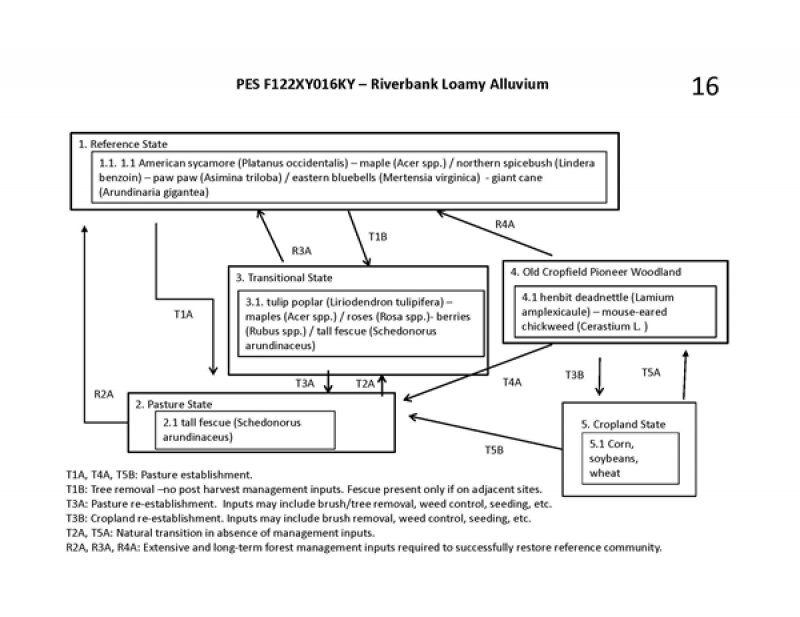
Natural Resources
Conservation Service
Ecological site F122XY016KY
Riverbank Loamy Alluvium
Last updated: 5/14/2025
Accessed: 12/21/2025
General information
Provisional. A provisional ecological site description has undergone quality control and quality assurance review. It contains a working state and transition model and enough information to identify the ecological site.
MLRA notes
Major Land Resource Area (MLRA): 122X–Highland Rim and Pennyroyal
MLRA 122 is in Tennessee (47 percent), Kentucky (43 percent), Indiana (7 percent), and Alabama (3 percent). It makes up about 21,530 square miles (55,790 square kilometers).
SOILS:
Many of the soils in this MLRA are Udalfs. The moderately deep to very deep, well drained, clayey soils formed in limestone residuum. They are dominantly in rolling to steep areas of the “Outer Basin” (Mimosa, Braxton, Gladdice, and Hampshire series) and the undulating to hilly areas of the “Inner Basin” (Talbott and Bradyville series). The most agriculturally productive soils are the very deep, well drained, clayey or loamy soils that formed in alluvium and/or loess over alluvium or limestone residuum in nearly level to undulating areas (Armour, Cumberland, Harpeth, Lomond, and Maury series). The less extensive soils generally are moderately well drained to somewhat poorly drained and formed in loamy or clayey alluvium and/or residuum (Byler, Capshaw, Colbert, and Tupelo series). This MLRA has a significant acreage of Mollisols. Shallow or moderately deep, well drained, clayey Udolls (Ashwood and Barfield series) formed in limestone residuum dominantly in rolling to steep areas. Very shallow, well drained, clayey Rendolls (Gladeville series) formed in limestone residuum dominantly in undulating to rolling areas of the “Inner Basin.” Very deep, well drained or moderately well drained Udolls (Arrington, Egam, Lynnville, and Staser series) and somewhat poorly drained or poorly drained Aquolls (Agee, Godwin, and Lanton series) formed in loamy or clayey alluvium derived from limestone on flood plains. Most of the remaining soils on flood plains are moderately well drained or well drained Udepts (Lindell and Ocana series). Udults are of small extent in this area. Most are very deep, well drained, and loamy and formed in gravelly colluvium or colluvium and the underlying residuum on steep hillsides (Dellrose soils). Rock outcrops are common on uplands.
BIOLOGICAL RESOURCES:
This area supports mixed oak forest vegetation. White oak, black oak, northern red oak, and some scarlet oak are the dominant tree species. Shagbark hickory, bitternut hickory, pignut hickory, and mockernut hickory also occur. Oak, blackgum, flowering dogwood, sassafras, Virginia pine, pitch pine, and shortleaf pine grow mostly on ridgetops.
(Excerpt from United States Department of Agriculture, Natural Resources Conservation Service. 2006. Land Resource Regions and Major Land Resource Areas of the United States, the Caribbean, and the Pacific Basin. U.S. Department of Agriculture Handbook 296.)
Classification relationships
Scientific Name: South-Central Interior Large Floodplain
Unique Identifier: CES202.705
Possible Association:
Platanus occidentalis - Acer saccharinum - Juglans nigra - Ulmus rubra Forest
Translated Name: American Sycamore - Silver Maple - Black Walnut - Slippery Elm Forest
Common Name: Sycamore - Silver Maple Calcareous Floodplain Forest
Unique Identifier: CEGL007334
Classification Approach: International Vegetation Classification (IVC)
Summary: This sycamore - silver maple floodplain forest occurs along riverfronts in calcareous areas of the east-central United
States, including forests along small streams. Stands are dominated by Platanus occidentalis, with a mixture of other species,
including Acer negundo, Acer saccharinum, Fraxinus americana, Fraxinus pennsylvanica, Juglans nigra, Ulmus americana, and
Ulmus rubra. Shrubs include Asimina triloba and Lindera benzoin. Vines may be abundant, including Parthenocissus quinquefolia and
Toxicodendron radicans. Herbaceous species include Arisaema triphyllum, Asarum canadense, Boehmeria cylindrica, Elymus
virginicus, Pilea pumila, Polygonum virginianum, and others.
Ecological site concept
This PES describes plant communities likely to be found on these soils but does not encompass the entire complexity or diversity potential of these sites. Future field work is required to delineate and develop a full ecological site description (ESD) which can be utilized for conservation and planning purposes.
Only two tree species can be selected for entry into the database as dominants; however, multiple tree species may be dominant on these sites and it will vary depending on soil depth, seed sources, management, and disturbance history.
State 1, Phase 1.1: Forestland.
Plant species dominant: American sycamore (Platanus occidentalis) – maple (Acer spp.) / northern spicebush (Lindera benzoin) – paw paw (Asimina triloba) / eastern bluebells (Mertensia virginica) - giant cane (Arundinaria gigantea)
State 2, Phase 2.1: Pastureland.
Plant species dominant:
Schedonorus arundinaceus (tall fescue). Species present are dependent upon seeding and management.
State: 3. Phase 3.1: Transitional (Abandoned Field)
Plant species dominant: maples (Acer spp.) – tuliptree (Liriodendron tulipifera) / berries (Rubus spp.) – roses (Rosa spp.) / fescue (Schedonorus arundinaceus)
This phase is best described as an old field habitat with a mixture of native and introduced grasses and a variety of native and non-native herbs, forbs, seedlings, and saplings. Tree seedlings and sapling may include maple, tulip poplar, ash, boxelder, cottonwood, and sycamore; however, species will depend on available seed sources.
State 4, Phase 4.1: Abandoned Cropland
Plant species dominant:
henbit deadnettle (Lamium amplexicaule) – mouse-eared chickweed (Cerastium L. )
Initially, annual weeds would be predominate followed by grasses, shrubs and pioneers trees. Species dependent upon naturally available seed sources or restoration activities.
State 5, Phase 5.1: Cropland.
Plant species dominants: dependent upon seeding and management.
Most common crops are corn and soybeans.
Restoration of states 2-5 to the reference community would require timber stand improvement activities to control non-native vegetation and promote desired hardwood and understory species.
Associated sites
| F122XY017KY |
Moist Alluvium Somewhat Poorly Floodplains Moist Alluvium |
|---|
Table 1. Dominant plant species
| Tree |
(1) Platanus occidentalis |
|---|---|
| Shrub |
(1) Lindera benzoin |
| Herbaceous |
(1) Mertensia virginica |
Click on box and path labels to scroll to the respective text.
